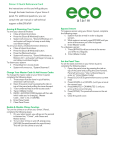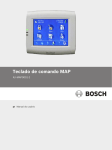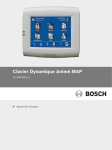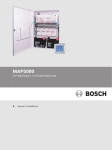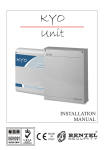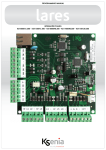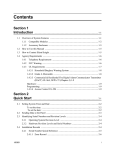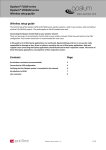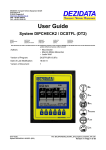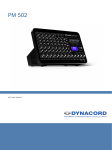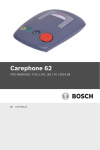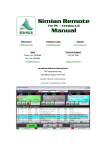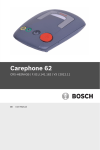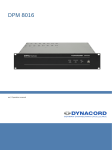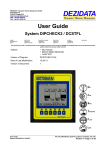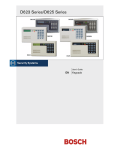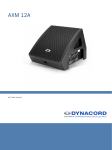Download MAP Control Center - Bosch Security Systems
Transcript
MAP Control Center IUI-MAP0001-2 en User Manual MAP Control Center Table of Contents | en 3 Table of Contents 1 System Overview 5 1.1 Certifications 5 1.2 Environmental Conditions for MAP Control Center 5 1.3 MAP Control Center Description 5 1.3.1 LCD Screen 5 1.3.2 MAP Control Center LEDs 5 1.4 Control Center Maintenance 6 1.5 Idle Screen 6 1.6 Logging In 6 1.7 Logging Off 7 1.8 Screen Elements 8 2 Operation 10 2.1 Alarm Tasks 10 2.1.1 Silence Alarms 10 2.1.2 Clear Alarms 10 2.1.3 View Event Memory 10 2.1.4 Clearing An Anti-masking Message 11 2.2 Searching and Sorting / Filtering 11 2.2.1 Search 12 2.2.2 Sort / Filter 13 2.3 Arm - Using the Control Center 13 2.3.1 Arm All Areas 15 2.3.2 Arm Selected Areas 15 2.3.3 Arm Control Panel (Local) Area 15 2.4 Disarm – Using the Control Center 16 2.4.1 Disarm All Areas 16 2.4.2 Disarm Selected Areas 16 2.4.3 Disarm Control Panel Area 17 2.5 Users 17 2.5.1 Add User 18 2.5.2 Delete User 28 2.5.3 Edit User 29 2.5.4 Change Passcode 31 2.6 Schedules 32 2.6.1 Arming an Area at a Pre-programmed Time 34 2.7 Status 34 2.7.1 View Area Status 34 2.7.2 View Device Status 37 2.7.3 Bypass / Unbypass Device 41 2.7.4 Unbypass All Devices 42 2.8 Service 43 2.8.1 Event History 44 2.8.2 View Version Information 48 2.8.3 Enable / Disable Device 48 2.8.4 Set Time and Date 50 2.8.5 Walk Test 50 2.8.6 Motion Detector Test 55 2.8.7 Bell Test 56 Bosch Sicherheitssysteme, GmbH User Manual 2014.11 | 06 | F.01U.168.328 4 en | Table of Contents MAP Control Center 2.8.8 Change / View Output State 57 2.8.9 Manufacturer Authorization 58 2.8.10 Adjust Volume / Brightness 59 2.8.11 Chime Mode On / Off 59 2.9 Internal Program 60 2.10 Event Memory 61 2.10.1 View Event Memory 61 2.10.2 Clear Event Memory 62 2.10.3 View Alarm Counter 62 2.10.4 Silence 62 2.11 RPS 63 2014.11 | 06 | F.01U.168.328 User Manual Bosch Sicherheitssysteme, GmbH MAP Control Center System Overview | en 1 System Overview 1.1 Certifications 5 The control center is designed to comply with the following certifications and standards: 1.2 1.3 Region Certification GERMANY VdS Class C, VdS G 111040 Europe CE Conformité Européene EN50131-1/3 grade 3 Alarm Systems – Intrusion Systems Environmental Conditions for MAP Control Center Operating temperature: -10 ºC to +55 ºC Relative humidity: 5% to 95% Type in accordance with EN 50131: Type B Environmental class II: EN 50131, VdS 2110 Use: Designed for indoor use MAP Control Center Description The MAP control center is an input device for the Modular Alarm Platform 5000 system. Each control center has a vibrant-color 14 cm (5.7 in.) LCD screen. The durable touch screen provides access to the various system functions through an interface with intuitive buttons. Users touch the images directly on the screen to arm, disarm, or select other menu options. The display text is shown in the language set by the user. 1.3.1 LCD Screen To operate the MAP control center, apply moderate pressure to the keys and buttons shown on the screen. To avoid damage to the touch-sensitive foil do not use sharp objects. 1.3.2 MAP Control Center LEDs Three light-emitting diodes (LEDs) are located on the left edge of the MAP control center ( Figure 1.1 Control Center LEDs, page 6): – Green LED: Indicates that the control center is communicating with the control panel. – Yellow LED: Indicates that there is a trouble condition, that sensors are covered, or that devices in the system are switched off or disabled. – Red LED: The default behavior indicates that an alarm condition exists in the security system Bosch Sicherheitssysteme, GmbH User Manual 2014.11 | 06 | F.01U.168.328 6 en | System Overview MAP Control Center Figure 1.1 Control Center LEDs 1 – Green LED 2 – Yellow LED 3 – Red LED 1.4 Control Center Maintenance If the control center housing is dirty, clean it with a soft dampened cloth. Do not use corrosive or abrasive cleaners. Make sure that no fluid gets inside of the housing. To remove fingerprints or dust from the LCD screen, use a soft cloth that you have dampened slightly with water. 1.5 Idle Screen The control center shows the Idle screen (Figure 1.2 Idle screen, page 6) when it is not in use. To use the system, touch the control center display. Figure 1.2 Idle screen 1.6 Logging In Use the Login screen (Figure 1.3 Login screen, page 7) to enter your passcode. The user passcode is made up of a three-digit user ID (004–999) and a six-digit user code, which is entered immediately after the user ID. 2014.11 | 06 | F.01U.168.328 User Manual Bosch Sicherheitssysteme, GmbH MAP Control Center System Overview | en 7 Figure 1.3 Login screen If the system does not recognize the passcode, the control center shows the Invalid Login screen (Figure 1.4 Invalid Login screen, page 7). To empty the passcode field, press Clear (the pencil eraser button). If an invalid passcode is entered ten1 times in succession, the control center is locked for two minutes1. Figure 1.4 Invalid Login screen After the user enters a valid passcode, the touch screen shows the Main Menu (Figure 1.5 Main Menu – screen 1, page 8 ). See also – 1.7 , page 9 Logging Off A user is logged off – By pressing the exit button (Table 1.1 Navigation Bar description, page 9) – If there has been no user activity on the control center for two minutes1 1 Programmable value Bosch Sicherheitssysteme, GmbH User Manual 2014.11 | 06 | F.01U.168.328 8 1.8 en | System Overview MAP Control Center Screen Elements Figure 1.5 Main Menu – screen 1 1. Screen name: identifies the active screen. 2. Menu buttons: Press a menu button to perform a task. 3. Installer Mode Icon: Indicates that the control panel is in installer mode. 4. RPS Connected Icon: Indicates that RPS is connected to the control panel. 5. Information button: If it is flashing, press this button to view additional system information and to clear the events, alarms or troubles. For more Event Memory information, refer to Section View Event Memory, page 10. – If the Information button is flashing red, there are system events and alarms that the user has not cleared. – If the Information button is flashing yellow, there are system troubles which the user has not cleared. – 6. If the Information button is green, no additional system information is available. Navigation bar: Press the buttons in the navigation bar to find tasks or to view system information. Refer to Table 1.1 Navigation Bar description, page 9. Buttons in the navigation bar that appear without their normal colors are not activated. 2014.11 | 06 | F.01U.168.328 User Manual Bosch Sicherheitssysteme, GmbH MAP Control Center System Overview | en 9 Figure 1.6 Main Menu – screen 2 Notice! The buttons on your touch screen might be different from the buttons shown in Figure 1.5 Main Menu – screen 1, page 8 and Figure 1.6 Main Menu – screen 2, page 9.The buttons on your touch screen are determined by your user authority level. After the user presses a button, the touch screen shows the task buttons contained within that folder. For example, Figure 2.45 Status menu, page 34 shows the Status tasks. Table 1.1 Navigation Bar description Button Description Back: Shows the previous screen. Home: Shows the Main Menu. Page up: Shows the previous page on screens with more than one page. Page down: Shows the next page on screens with more than one page. Help: Shows helpful information about the active screen. Exit: Logs the user off and switches the display to the idle screen (Figure 1.2 Idle screen, page 6). Bosch Sicherheitssysteme, GmbH User Manual 2014.11 | 06 | F.01U.168.328 10 en | Operation MAP Control Center 2 Operation 2.1 Alarm Tasks 2.1.1 Silence Alarms If the system generates an alarm, press the touch screen and enter your passcode (Figure 1.3 Login screen, page 7). If the system accepts your user passcode, the touch screen shows the first alarm, e.g. an external intrusion alarm (Figure 2.1 External Intrusion Alarm screen, page 10) and the latest alarm. Any trouble events in the system are not shown on this display. Figure 2.1 External Intrusion Alarm screen To silence the alarm, press Silence. If the system recorded more than one alarm, the screen shows the first and last alarms. Press View More to see all current events in the event memory. For more information about event memory, refer to Section View Event Memory, page 10. 2.1.2 Clear Alarms After silencing an alarm, the user must clear the alarm. From the alarm screen (Figure 2.1 External Intrusion Alarm screen, page 10), press View More to open the View Event Memory screen (Figure 2.2 View Event Memory screen, page 11). To clear the alarm, press Clear Events . 2.1.3 View Event Memory If the Information button on the Main Menu (Figure 1.5 Main Menu – screen 1, page 8) flashes red or yellow, press the Information button to view the View Event Memory screen (Figure 2.2 View Event Memory screen, page 11). For additional event memory options, refer to Section Event Memory, page 61. 2014.11 | 06 | F.01U.168.328 User Manual Bosch Sicherheitssysteme, GmbH MAP Control Center Operation | en 11 Figure 2.2 View Event Memory screen Notice! The system displays events with the newest event being displayed first. If your passcode authorizes the clearing of alarms and other events, press Clear Events. If you cannot clear certain events because you do not have the necessary access rights, then the Not Authorized screen appears on the control center. In this case, please notify your installer or maintenance engineer. For more information about viewing event memory, refer to Section View Event Memory, page 10. 2.1.4 Clearing An Anti-masking Message 1. Turn on the walk test for the area in which the point is located (refer to Section Motion Detector Test, page 55). 2.2 2. Remove the object masking the point and then trigger the point using motion. 3. Turn off the walk test again. The anti-masking message is now cleared. Searching and Sorting / Filtering Some functions in the MAP system user interface call for or require searching, sorting, or filtering. Where these functions are possible, the Search and Sort / Filter (Table 2.1 Search and Sort / Filter button descriptions, page 11) buttons appear on the screen. Table 2.1 Search and Sort / Filter button descriptions Button Description Search: Shows the Alphanumeric Keypad screen (Figure 2.3 1. Alphanumeric Keypad screen 1, page 12). Sort/Filter: Shows a list of sort categories appropriate to the function, and the A-Z and Z-A buttons. A-Z: Sorts in alphabetical order. Bosch Sicherheitssysteme, GmbH User Manual 2014.11 | 06 | F.01U.168.328 12 en | Operation MAP Control Center Button Description Z-A: Sorts in reverse alphabetical order. Figure 2.3 1. Alphanumeric Keypad screen 1 Figure 2.4 2. Alphanumeric Keypad screen 2 2.2.1 Search Search uses an alphanumeric keypad display for input. The alphanumeric keypad display has the numerals 0 - 9, a QWERTY arrangement of letters with additional special characters, and five commands (refer to Table 2.2 Alphanumeric Keypad Command descriptions, page 12). Table 2.2 Alphanumeric Keypad Command descriptions Command Description Shift Creates capital letters. Press once. The next letter pressed is capitalized. Clear Clears all input in the Search field. Space Inserts a space (same function as the spacebar on a manual keyboard). Backspace Clears the previous character. 2014.11 | 06 | F.01U.168.328 User Manual Bosch Sicherheitssysteme, GmbH MAP Control Center 2.2.2 Operation | en Command Description Enter Starts the search process. 13 Sort / Filter When you use the Sort / Filter function, the sorting can be alphabetical (from A - Z or from Z to A) for all devices or all areas, for example, or the function can be narrowed by selecting faulted, bypassed, unbypassed, enabled, or disabled devices. All areas can be sorted, or the sorting function can be narrowed by selecting armed, disarmed, ready to arm, not ready to arm, ready to disarm, or not ready to disarm areas. More information is provided in the sections that cover the commands that allow sorting and filtering. 2.3 Arm - Using the Control Center Notice! A system installed with Smartkey or Blocklock controls can only be armed or disarmed by those controls. It cannot be armed or disarmed using a control center. The Arm menu allows the user to arm all areas, arm selected areas, or arm the control panel area. Notice! For the system default, the area containing the control center is the local area. During installation, each control center can be assigned to a specific area making that area the local area for that control center. Therefore, the displayed button name on each control center is unique for each installation. Depending on how your system is configured, you might need to arm the control panel area first. On the Main Menu (Figure 1.5 Main Menu – screen 1, page 8), press Arm, then select an arming option from the on-screen buttons (Arm All Areas, Arm Selected Areas, or Arm Control Panel Area) on the Arm Menu (Figure 2.5 Arm menu, page 14). Selecting an area that is Ready to Arm initiates the arming sequence and displays the Exit Delay screen (Figure 2.6 Exit Delay screen, page 14) which indicates how much time you have to evacuate the arming area(s) before your presence sets off an alarm. Selecting an area that is Not Ready to Arm displays an Arming Failure screen (Figure 2.7 Arming Failure screen, page 14) which indicates which area(s) can be force armed [armed by forcing bypass (refer to Section Bypass / Unbypass Device, page 41) of all points that are not ready to be armed] and which areas cannot be force armed. Notice! Force arming is not available when a related area must be armed first, when too many points are already bypassed, or when an area contains specific unbypassable points. Bosch Sicherheitssysteme, GmbH User Manual 2014.11 | 06 | F.01U.168.328 14 en | Operation MAP Control Center Figure 2.5 Arm menu Notice! Clicking on the Not Ready to Arm icon ( ) provides information on why the area is not ready to arm. Figure 2.6 Exit Delay screen Figure 2.7 Arming Failure screen 2014.11 | 06 | F.01U.168.328 User Manual Bosch Sicherheitssysteme, GmbH MAP Control Center 2.3.1 Operation | en 15 Arm All Areas From the Arm menu, press the Arm All Areas button. As above, if all areas are Ready to Arm, the Exit Delay screen is displayed; if not, the Arming Failure screen opens with the lock button in the locked position and the armed status showing on the Arm All Areas button. 2.3.2 Arm Selected Areas From the Arm menu (Figure 2.5 Arm menu, page 14), press the Arm All Areas button. The Arm Selected Areas screen (Figure 2.8 Arm Selected Areas screen, page 15) opens. The text and the lock button show status information on the button for each area. To arm an area, press the button for an area that is not already armed; then press the Arm button. Figure 2.8 Arm Selected Areas screen To sort the list of areas before selecting some to arm, press the Sort / Filter button. Refer to Table 2.3 Arming indicators, page 15 for the possible arming indicators. Table 2.3 Arming indicators Indicator Description Disarmed Area currently disarmed Ready to Arm All points in the area are ready to arm Not Ready to Arm Some points in the area are faulted and not ready to arm; all points must either be returned to normal or bypassed. Armed 2.3.3 Area currently armed Arm Control Panel (Local) Area From the Arm menu (Figure 2.5 Arm menu, page 14), press the Arm Control Panel Area button. Notice! Depending on how your system is configured, the displayed button name on each control center is unique for each installation. The Arm menu opens with the lock button in the locked position and the area’s armed status showing on the Arm Control Panel Area button. Bosch Sicherheitssysteme, GmbH User Manual 2014.11 | 06 | F.01U.168.328 16 en | Operation 2.4 MAP Control Center Disarm – Using the Control Center The Disarm menu allows the user to disarm all areas, disarm selected areas, or disarm the entire control panel (or installation-specific local) area. On the Main Menu (Figure 1.5 Main Menu – screen 1, page 8), press Disarm, then select a disarming option from the on-screen buttons on the Disarm menu (Figure 2.9 Disarm menu, page 16). Figure 2.9 Disarm menu 2.4.1 Disarm All Areas From the Disarm menu (Figure 2.9 Disarm menu, page 16), press the Disarm All Areas button. The control center display shows the message: Attention - All authorized areas are disarmed (Figure 2.10 Attention message: All authorized areas are disarmed, page 16). Then the Disarm menu opens with the lock button in the unlocked position and the disarmed status showing on the Disarm All Areas button. Figure 2.10 Attention message: All authorized areas are disarmed 2.4.2 Disarm Selected Areas From the Disarm menu, press the Disarm Selected Areas button. The Disarm Selected Areas screen (Figure 2.11 Disarm Selected Areas screen, page 17) opens. The text and the lock button show status information on the button for each area. To disarm an area, press the button for an area that is not already disarmed; then press the Disarm button. To sort the list of areas before selecting some to disarm, press the Sort/Filter button. 2014.11 | 06 | F.01U.168.328 User Manual Bosch Sicherheitssysteme, GmbH MAP Control Center Operation | en 17 Figure 2.11 Disarm Selected Areas screen 2.4.3 Disarm Control Panel Area From the Disarm menu (Figure 2.9 Disarm menu, page 16), press the Disarm Control Panel Area button. Usually, this button is the area where the control center is located, but it could be any area designated as the local area. The button name is unique at each installation. To disarm the control panel area, press the Control Panel Area button then press the Disarm button. The lock icon on the Control Panel Area button changes to the unlocked position and the area's disarmed status shows on the button. 2.5 Users Notice! The options to perform user-related operations are restricted by permission set / access profile. The Users menu allows the user to add (up to the maximum number of users allowed), delete or edit a user’s profile or to change a user’s passcode. On the Main Menu (Figure 1.5 Main Menu – screen 1, page 8) press Users, then select the user category from the on-screen buttons (Figure 2.12 Users menu, page 17). Figure 2.12 Users menu Bosch Sicherheitssysteme, GmbH User Manual 2014.11 | 06 | F.01U.168.328 18 en | Operation MAP Control Center See also – 2.5.1 Users, page 17 Add User Notice! A Smartkey user must also be entered as a control center user. Refer to Section Add Smartkey User, page 21. A control center user is not required to be a Smartkey user. Refer to Section Add Control Center User, page 23. – From the Users menu (Figure 2.12 Users menu, page 17), press Add User. The Add User screen (Figure 2.13 Add User screen, page 18) opens Figure 2.13 Add User screen Enter User ID – From the Add User screen (Figure 2.13 Add User screen, page 18), press Enter User ID. The Enter User ID screen (Figure 2.14 Enter User ID screen, page 18) opens. Figure 2.14 Enter User ID screen – Press Enter User ID to enter a specific three-digit user ID, or press Request Next Available User ID to have the system assign a user ID. When you select Enter User ID, the Enter User ID telephone keypad display screen (Figure 2.15 Enter User ID Keypad screen, page 19) opens. 2014.11 | 06 | F.01U.168.328 User Manual Bosch Sicherheitssysteme, GmbH MAP Control Center Operation | en – 19 Press the numbered buttons on the keypad screen. Each number appears in the Enter new user ID field. Press Clear to make corrections. – Press OK to enter the specific user ID. Figure 2.15 Enter User ID Keypad screen – The assigned user ID appears in lighter text under the button name on a confirmation screen (Figure 2.16 User ID Control Center Confirmation screen, page 19). Press OK to complete the entry. Figure 2.16 User ID Control Center Confirmation screen Enter User Name – From the Add User screen (Figure 2.13 Add User screen, page 18), press Enter User Name . The Enter User Name screen (Figure 2.17 Enter User Name screen, page 20) opens. Bosch Sicherheitssysteme, GmbH User Manual 2014.11 | 06 | F.01U.168.328 20 en | Operation MAP Control Center Figure 2.17 Enter User Name screen – On the Enter User Name screen, press Enter User First Name. The alphanumeric keypad screen (Figure 2.18 1. Enter User Name - Alphanumeric keypad screen 1, page 20) opens. Also refer to Figure 2.19 2. Enter User Name - Alphanumeric keypad screen 2, page 21 – Use the alphanumeric buttons to enter the user’s first name. Refer to Table 2.3 Arming indicators, page 15 for information about using the commands at the bottom of the screen. – Press Enter to complete the entry. The user’s first name appears in lighter text under the Enter User First Name button name. Figure 2.18 1. Enter User Name - Alphanumeric keypad screen 1 2014.11 | 06 | F.01U.168.328 User Manual Bosch Sicherheitssysteme, GmbH MAP Control Center Operation | en 21 Figure 2.19 2. Enter User Name - Alphanumeric keypad screen 2 – On the Enter User Name screen, press Enter User Last Name. – On the alphanumeric keypad screen, enter the user’s last name. Refer to Table 2.3 Arming indicators, page 15 for information about using the commands at the bottom of the screen. – Press Enter to complete the entry. The user’s last name appears in lighter text under the Enter User Last Name button name. – Press Enter to complete the User Name entry. Add Smartkey User – To designate a Smartkey user, press Add Smartkey User on the Add User screen (Figure 2.13 Add User screen, page 18). The Add Smartkey User screen (Figure 2.20 Add Smartkey User screen, page 21) opens. Figure 2.20 Add Smartkey User screen Notice! The next three steps are optional in the Add User procedure. Bosch Sicherheitssysteme, GmbH User Manual 2014.11 | 06 | F.01U.168.328 22 en | Operation MAP Control Center – If you wish to enter the Smartkey token’s ID number at the control center, press Enter Smartkey Token Number. The Enter Smartkey Token Number keypad screen (Figure 2.21 Enter Smartkey Token Number keypad screen, page 22) opens. Refer to Table 2.3 Arming indicators, page 15 for information about using the commands at the bottom of the screen. – Use the on-screen keypad to enter the 8-character ID found on the Smartkey token. The code appears in the Enter field and a Verify Code field appears. – Enter the same code again. The code appears in the Verify Code field. – Press OK. If the token number in the Enter field matches the number entered in the Verify Code field, the Smartkey token number appears in lighter text under the Enter Smartkey Token Number button name on the Add Smartkey User screen. If these numbers do not match, an error message is displayed, and you must re-enter the token number and verify code. Figure 2.21 Enter Smartkey Token Number keypad screen – On the Add Smartkey User screen (Figure 2.20 Add Smartkey User screen, page 21), press Select Smartkey Profile. The Select Smartkey Profile screen (Figure 2.23 Select Smartkey Profile screen, page 23) opens. Notice! If no Smartkey profiles are programmed, the message Attention - Use RPS to Add Smartkey Configuration (Figure 2.22 Attention – Use RPS to Add Smartkey Configuration, page 23) appears. 2014.11 | 06 | F.01U.168.328 User Manual Bosch Sicherheitssysteme, GmbH MAP Control Center Operation | en 23 Figure 2.22 Attention – Use RPS to Add Smartkey Configuration – Press a button on the Select Smartkey Profile screen to select one of the Smartkey profiles; then press OK. Figure 2.23 Select Smartkey Profile screen A symbol appears on the Add Smartkey User button. Add Control Center User – From the Add User screen (Figure 2.13 Add User screen, page 18), press Add Control Center User. The Add Control Center User screen (Figure 2.24 Add Control Center User screen, page 24) opens. Bosch Sicherheitssysteme, GmbH User Manual 2014.11 | 06 | F.01U.168.328 24 en | Operation MAP Control Center Figure 2.24 Add Control Center User screen – Press Select User Type. The Select User Type screen (Figure 2.25 Select User Type screen, page 24) opens. – If you press the Standard User button, a ( – If you press Temporary User, a ) symbol appears on the button. symbol appears on the button and the Temporary User Duration keypad screen (Figure 2.26 Temporary User Duration keypad screen, page 25) opens. Use the screen keypad to enter the number of days (0 to 99) to allow access for the temporary user; then press OK to return to the Select User Type screen. Notice! A temporary user with 0 days validity is an inactive user. Inactive users can be activated by using RPS for MAP. Figure 2.25 Select User Type screen 2014.11 | 06 | F.01U.168.328 User Manual Bosch Sicherheitssysteme, GmbH MAP Control Center Operation | en 25 Figure 2.26 Temporary User Duration keypad screen – Press OK. The selected user type appears in lighter text under the Select User Type button name on the Add Control Center User screen. – From the Add Control Center User (Figure 2.24 Add Control Center User screen, page 24) screen, Select User Profile. The Select User Profile screen (Figure 2.27 Select User Profile screen, page 25) opens. Figure 2.27 Select User Profile screen – From the Select User Profile screen (Figure 2.27 Select User Profile screen, page 25) select a user profile. A symbol appears on the selected button (Figure 2.28 User Profile Selection: Standard User, page 26). Bosch Sicherheitssysteme, GmbH User Manual 2014.11 | 06 | F.01U.168.328 26 en | Operation MAP Control Center Figure 2.28 User Profile Selection: Standard User – Press OK. The selected user profile appears in lighter text under the Select User Profile button name. – From the Add Control Center User (Figure 2.24 Add Control Center User screen, page 24) screen, Select User Language. The Select User Language screen (Figure 2.29 Select User Language, page 26) opens. – From the Select User Language screens (1 or 2), select German, English, French or Dutch. A symbol appears on the selected button. Figure 2.29 Select User Language – Press the OK button. The selected language appears in lighter text under the Select User Language button name. – From the Add Control Center User screen, Select Exit Delay. The Select Exit Delay screen (Figure 2.30 Select Exit Delay screen, page 27) opens. – From the Select Exit Delay screen, select Standard or Extended. A symbol appears on the selected button (Figure 2.30 Select Exit Delay screen, page 27). 2014.11 | 06 | F.01U.168.328 User Manual Bosch Sicherheitssysteme, GmbH MAP Control Center Operation | en 27 Figure 2.30 Select Exit Delay screen – Press the OK button. The selected exit delay type appears in lighter text under the Select Exit Delay button name. – When all buttons on the Add Control Center User screen (Figure 2.24 Add Control Center User screen, page 24) show an entry in lighter text, press OK. The Add User screen opens. Completing Add User – When the entries are completed on the Add User screen (Figure 2.31 Completed Add User screen, page 27), entries in lighter text should appear under the Enter User ID and Enter User Name buttons. A symbol should appear on either the Add Smartkey User or Add Control Center User button. Notice! Until all of the above steps are completed, the Add User button will be in lighter text. Figure 2.31 Completed Add User screen – Press the Add User button. The screen briefly shows the message Attention - Request to: Add User Succeeded (Figure 2.32 Attention: Add User Succeeded, page 28). Then the Users menu appears. Bosch Sicherheitssysteme, GmbH User Manual 2014.11 | 06 | F.01U.168.328 28 en | Operation MAP Control Center Figure 2.32 Attention: Add User Succeeded 2.5.2 Delete User From the Users menu (Figure 2.12 Users menu, page 17), press the Delete User button. The Delete User screen (Figure 2.33 Delete User screen, page 28) opens. If necessary, press the Search or Sort / Filter button to find the user. Refer to Section 2.2 Searching and Sorting / Filtering, page 11. Figure 2.33 Delete User screen From the Delete User screen, press one of the menu buttons containing a user's name. A message appears asking for confirmation (Figure 2.34 Confirm Delete User screen, page 29). To proceed, press the Confirm Delete button. If you do not want to delete that user, press the Back button. 2014.11 | 06 | F.01U.168.328 User Manual Bosch Sicherheitssysteme, GmbH MAP Control Center Operation | en 29 Figure 2.34 Confirm Delete User screen 2.5.3 Edit User From the Users menu (Figure 2.12 Users menu, page 17), press Edit User. The Edit User screen (Figure 2.35 Edit User screen, page 29) opens with a list of users. Find the user you wish to edit and press the corresponding button. The Edit User - User ID screen (Figure 2.36 Edit User – User ID screen, page 30) opens. Figure 2.35 Edit User screen Bosch Sicherheitssysteme, GmbH User Manual 2014.11 | 06 | F.01U.168.328 30 en | Operation MAP Control Center Figure 2.36 Edit User – User ID screen From the Edit User - User ID screen, you can reset the passcode, edit the user name, edit a Smartkey user, and edit a control center user. Reset Passcode From the Edit User - User ID screen (Figure 2.36 Edit User – User ID screen, page 30), press Reset Passcode. A list of users appears. Press the button for the user whose passcode you wish to reset. A message appears indicating that the request to reset the passcode succeeded. Edit User Name From the Edit User - User ID screen (Figure 2.36 Edit User – User ID screen, page 30), press Edit User Name. The Enter User Name screen (Figure 2.17, Page 19) opens. Press either Enter User First Name or Enter User Last Name. The alphanumeric keypad display screen (Figure 2.18, Page 20) opens with the name showing in the Enter User Name field. Use the editing buttons at the bottom of the screen and the alphanumeric keys to make the desired changes. Press the Enter button to return to the Enter User Name screen. Press the OK button to return to the Edit User - User ID screen. Edit Smartkey User From the Edit User - User ID screen (Figure 2.36 Edit User – User ID screen, page 30), press Edit Smartkey User. The Edit Smartkey User screen (Figure 2.37 Edit Smartkey User screen, page 30) opens. Figure 2.37 Edit Smartkey User screen 2014.11 | 06 | F.01U.168.328 User Manual Bosch Sicherheitssysteme, GmbH MAP Control Center Operation | en 31 If you wish to add or change a Smartkey token number, press the Enter Smartkey Token button. The Enter Smartkey Token Number keypad screen (Figure 2.21 Enter Smartkey Token Number keypad screen, page 22) opens. Refer to Section Add Smartkey User, page 21 for instructions on entering (or editing) the Smartkey token's hexadecimal number on the keypad screen. Edit Control Center User From the Edit User - User ID screen (Figure 2.36 Edit User – User ID screen, page 30), press Edit Control Center User. The Edit Control Center User screen (Figure 2.38 Edit Control Center User screen, page 31) opens. Refer to Section Add Control Center User, page 23 for instructions on adding or editing information about the control center user. Figure 2.38 Edit Control Center User screen 2.5.4 Change Passcode To change a logged-in user’s passcode, press Change Passcode. The Change Passcode screen (Figure 2.39 Change Passcode screen, page 31) opens. Using the on-screen numeric keypad, enter the new passcode in the Enter New Passcode field, then verify the new passcode by entering it again in the Verify New Passcode field. Figure 2.39 Change Passcode screen Bosch Sicherheitssysteme, GmbH User Manual 2014.11 | 06 | F.01U.168.328 32 2.6 en | Operation MAP Control Center Schedules The Schedules screen allows the user to view or edit a programmed schedule. On the Main Menu (Figure 1.5 Main Menu – screen 1, page 8), press Schedules. The Schedules screen ( Figure 2.40 Schedules screen, page 32) opens with a list of the schedules programmed into the system. Figure 2.40 Schedules screen To find a schedule to view or change, the user can search or sort the list. Press the Search button to show the alphanumeric keypad screen (Figure 2.41 1. Search Schedules screen 1, page 32). Use the numeric, alphabetic, and command keys to enter the name of a schedule. The name appears in the Search Schedules field. Press the Enter button to start the search. Figure 2.41 1. Search Schedules screen 1 2014.11 | 06 | F.01U.168.328 User Manual Bosch Sicherheitssysteme, GmbH MAP Control Center Operation | en 33 Figure 2.42 2. Search Schedules screen 2 To sort or filter the list of schedules, press the Sort / Filter button. The Sort / Filter Schedules screen opens. Select a filter category from the list: – List All Schedules – List Inactive Schedules – List Active Schedules Press the A - Z or Z - A button to select the sorting sequence. Press the OK button to start the sorting. For more information on searching, sorting, and filtering, refer to Section Searching and Sorting / Filtering, page 11. Figure 2.43 Sort/Filter Schedules screen To view or edit a schedule, press the schedule’s button. The Change Schedule screen (Figure 2.44 Change Schedule screen, page 34) opens. By pressing the schedule’s button, the user can: – Disable the schedule ( – Enable the schedule ( ), or ) (Figure 2.40 Schedules screen, page 32). Using the Hours and Minutes buttons and the + and - buttons, the user can edit the time of the schedule. Press the OK button to accept the changes. A message appears briefly stating that the request to change the schedule has succeeded. Bosch Sicherheitssysteme, GmbH User Manual 2014.11 | 06 | F.01U.168.328 34 en | Operation MAP Control Center Figure 2.44 Change Schedule screen See also 2.6.1 – Schedules, page 33 – Schedules, page 33 Arming an Area at a Pre-programmed Time If the system has been programmed to arm an area at a specific time, the keypad emits an interval tone when the alarm is activated and the Exit Delay screen (Figure 2.6 Exit Delay screen, page 14) is shown. The Exit Delay screen indicates how much time you have to exit the area before your presence triggers an alarm. 2.7 Status The Status menu provides access to functions for viewing the system status. From the Main Menu (Figure 1.5 Main Menu – screen 1, page 8), press Status, then select the status category from the on-screen buttons (Figure 2.45 Status menu, page 34). Figure 2.45 Status menu 2.7.1 View Area Status From the Status menu (Figure 2.45 Status menu, page 34), press View Area Status. The View Area Status screen (Figure 2.46 View Area Status screen, page 35) opens. 2014.11 | 06 | F.01U.168.328 User Manual Bosch Sicherheitssysteme, GmbH MAP Control Center Operation | en 35 Figure 2.46 View Area Status screen The + symbol is displayed when an area is Not Ready to Arm or Not Ready to Disarm, or when an area is Ready to Arm but can only be armed by a Smartkey or Blocklock. Pressing a displayed + symbol opens a View Area Status Detail screen (Figure 2.47 View Area Status Detail screen, page 35). Figure 2.47 View Area Status Detail screen To find an area to view, the user can search or sort the list on the View Area Status screen ( Figure 2.46 View Area Status screen, page 35). Press the Search button to show the alphanumeric keypad screen (Figure 2.48 1. Search View Area Status screen 1, page 36). Use the numeric, alphabetic, and command keys to enter an area's name. The name appears in the Search View Area Status field. Press the Enter button to start the search. Bosch Sicherheitssysteme, GmbH User Manual 2014.11 | 06 | F.01U.168.328 36 en | Operation MAP Control Center Figure 2.48 1. Search View Area Status screen 1 Figure 2.49 2. Search View Area Status screen 2 To sort or filter the list of areas, press the Sort / Filter button. The Sort / Filter: View Area Status screen (Figure 2.50 1. Sort/Filter View Area Status screen 1, page 37, see alsoFigure 2.51 2. Sort/Filter View Area Status screen 2, page 37) opens. Select a filter category from the list: – List All Areas – List Armed Areas – List Disarmed Areas – List Ready To Arm Areas – List Not Ready To Arm Areas – List Ready To Disarm Areas – List Not Ready To Disarm Areas Press the A - Z or Z - A button to select the sorting sequence. For more information on searching, sorting, and filtering, refer to Section Searching and Sorting / Filtering, page 11. 2014.11 | 06 | F.01U.168.328 User Manual Bosch Sicherheitssysteme, GmbH MAP Control Center Operation | en 37 Figure 2.50 1. Sort/Filter View Area Status screen 1 Figure 2.51 2. Sort/Filter View Area Status screen 2 See also – 2.7.2 View Area Status, page 36 View Device Status From the Status menu (Figure 2.45 Status menu, page 34), press View Device Status. The Device Status Select screen (Figure 2.52 Device Status Select screen, page 38) opens. Bosch Sicherheitssysteme, GmbH User Manual 2014.11 | 06 | F.01U.168.328 38 en | Operation MAP Control Center Figure 2.52 Device Status Select screen From the Device Status Select screen, press Select Area or All Devices. – If Select Area is pressed, the Select Area screen (Figure 2.53 Select Area screen, page 38 ) opens. Press the button for an area. The View Device Status screen (Figure 2.54 View Device Status screen, page 39) opens with a list of the devices in the selected area. Figure 2.53 Select Area screen – If All Devices is pressed, the View Device Status screen (Figure 2.54 View Device Status screen, page 39) opens with a list of all devices. The device status shows in lighter text under the device name. 2014.11 | 06 | F.01U.168.328 User Manual Bosch Sicherheitssysteme, GmbH MAP Control Center Operation | en 39 Figure 2.54 View Device Status screen To find a device to view, the user can search or sort the list. Press the Search button to show the Search View Device Status screen (Figure 2.55 Search View Device Status screen 1, page 39). Use the numeric, alphabetic, and command keys to enter a device's name. The name appears in the Search View Device Status field. Press the Enter button to start the search. Figure 2.55 Search View Device Status screen 1 Figure 2.56 Search View Device Status screen 2 To sort or filter the list of devices, press the Sort / Filter button. The Sort / Filter: View Device Status Screen (Figure 2.57 Sort / Filter View Device Status screen, page 40) opens. Bosch Sicherheitssysteme, GmbH User Manual 2014.11 | 06 | F.01U.168.328 40 en | Operation MAP Control Center Notice! If the user comes to this menu through Select Area, then the following filter displays the corresponding status for the devices in that area only. Select a filter category from the list: – List All Devices – List Faulted Devices – List Bypassed Devices – List Unbypassed Devices – List Disabled Devices – List Enabled Devices Then press the A - Z or Z - A button to select the sorting sequence. For more information on searching, sorting, and filtering, refer to Section Searching and Sorting / Filtering, page 11. Figure 2.57 Sort / Filter View Device Status screen Press one of the device buttons to view additional details of that device. A View Device Status Detail screen (Figure 2.58 View Device Status Detail screen, page 40) opens showing the details for the selected device. Figure 2.58 View Device Status Detail screen See also – 2014.11 | 06 | F.01U.168.328 View Device Status, page 39 User Manual Bosch Sicherheitssysteme, GmbH MAP Control Center 2.7.3 Operation | en 41 Bypass / Unbypass Device To arm the system, regardless of a particular device’s status, the user can bypass that device. Notice! A device cannot be bypassed if the area containing the device is armed, there is an active event in the system from the area containing the device, or if the device is in Walk Test. For example, if a window contact is installed on a window that the user wants to leave open, the user can bypass that window contact point. This allows the user to arm the system even though the window contact point’s status is Active. Notice! Bypassing a device only disables the device’s ability to notify the security system of an alarm or trouble event. Tamper events are still active in a bypassed device. From the Status menu (Figure 2.45 Status menu, page 34), press Bypass / Unbypass Device. The Bypass / Unbypass Device screen (Figure 2.59 Bypass/Unbypass Device screen, page 41) lists the devices and displays whether each device is either: – Bypassed ( – Unbypassed ( ), or ). Press a device’s on-screen button to change its bypass status. Figure 2.59 Bypass/Unbypass Device screen To find a specific device, the user can search or sort the list. Press the Search button to show the Search Bypass / Unbypass Device screen (Figure 2.60 Search Bypass / Unbypass Device screen, page 42). Use the numeric, alphabetic, and command keys to enter a device's name. The name appears in the Search Bypass / Unbypass Device field. Press the Enter button to start the search. Bosch Sicherheitssysteme, GmbH User Manual 2014.11 | 06 | F.01U.168.328 42 en | Operation MAP Control Center Figure 2.60 Search Bypass / Unbypass Device screen To sort or filter the list of devices, press the Sort / Filter button. The Sort/Filter Bypass / Unbypass Device screen (Figure 2.61 Sort/Filter Bypass/Unbypass Device screen, page 42) opens. Select a filter category from the list: – List All Devices – List Faulted Devices – List Bypassed Devices – List Unbypassed Devices Then press the A - Z or Z - A button to select the desired sorting sequence. For more information on searching, sorting, and filtering, refer to Section 2.2 Searching and Sorting / Filtering, page 11. Figure 2.61 Sort/Filter Bypass/Unbypass Device screen 2.7.4 Unbypass All Devices To unbypass all bypassed devices, press Unbypass All Devices on the Status menu (Figure 2.45 Status menu, page 34). The Attention - Request to: Unbypass All Devices Succeeded screen (Figure 2.62 Unbypass All Devices Succeeded screen, page 43) opens, and all bypassed devices return to their unbypassed state (Normal, Faulted, Missing, Trouble). 2014.11 | 06 | F.01U.168.328 User Manual Bosch Sicherheitssysteme, GmbH MAP Control Center Operation | en 43 Figure 2.62 Unbypass All Devices Succeeded screen 2.8 Service The Service menu provides access to system service functions. On the Main Menu (Figure 1.5 Main Menu – screen 1, page 8), press the Service button. The Service menu (Figure 2.63 Service Menu – screen 1, page 43, Figure 2.64 Service Menu – screen 2, page 43 and Figure 2.65 Service Menu – screen 3, page 44) opens. Figure 2.63 Service Menu – screen 1 Figure 2.64 Service Menu – screen 2 Bosch Sicherheitssysteme, GmbH User Manual 2014.11 | 06 | F.01U.168.328 44 en | Operation MAP Control Center Figure 2.65 Service Menu – screen 3 2.8.1 Event History From the Service menu (Figure 2.63 Service Menu – screen 1, page 43), press the Event History button. The Event History screen (Figure 2.66 Event History screen – screen 1, page 44) opens. Refer also to the Event History screen - page 2 (Figure 2.67 Event History screen – screen 2, page 45). The user can select from: – View History – Print History – Filter By Date Range – Filter By Event Type – Sort By Figure 2.66 Event History screen – screen 1 2014.11 | 06 | F.01U.168.328 User Manual Bosch Sicherheitssysteme, GmbH MAP Control Center Operation | en 45 Figure 2.67 Event History screen – screen 2 View History On the Event History screen, press the View History button. The View History screen (Figure 2.68 View History screen, page 45) opens with a list of the events stored in the control panel's history memory. These events are not limited to events initiated by the system’s sensors. All system activity, such as arming and disarming the system, system troubles, system tampers, and so on are listed on the View History screen. The default history filter is the last 24 hours. To expand the time range, select Filter by Date Range (refer to Section Filter By Date Range, page 46). To view only sensor events, refer to Section Event Memory, page 61. Figure 2.68 View History screen Print History On the Event History screen (Figure 2.66 Event History screen – screen 1, page 44), press Print History. The system prints the history data using the system printer. The control center display shows the message: Attention - Request to: Print History Succeeded (Figure 2.69 Print History Succeeded screen, page 46) or The printer is not ready. Bosch Sicherheitssysteme, GmbH User Manual 2014.11 | 06 | F.01U.168.328 46 en | Operation MAP Control Center Figure 2.69 Print History Succeeded screen Filter By Date Range On the Event History screen (Figure 2.66 Event History screen – screen 1, page 44), press Filter By Date Range. The Filter: Event History Dates screen (Figure 2.70 Filter: Event History Dates screen, page 46) opens. Press Beginning Date or Ending Date, then touch the date and time buttons to select the element to change. Press the + and - buttons to change the dates in the range. Figure 2.70 Filter: Event History Dates screen Filter By Event Type On the Event History screen (Figure 2.66 Event History screen – screen 1, page 44), press Filter By Event Type. The Filter: Event History Type screen opens (refer to Figure 2.71 Filter: Event History Type screen – screen 1, page 47andFigure 2.72 Filter: Event History Type screen – screen 2, page 47). The user can select an option from the following list: – All Events – Alarm Events – Trouble Events – System Events – Arm / Disarm Events – Operation Events – Maintenance Events After an option is pressed, the screen returns to the Event History screen. The selected event 2014.11 | 06 | F.01U.168.328 User Manual Bosch Sicherheitssysteme, GmbH MAP Control Center Operation | en 47 type appears in lighter text on the Filter By Event Type button. Figure 2.71 Filter: Event History Type screen – screen 1 Figure 2.72 Filter: Event History Type screen – screen 2 Sort By On the Event History screen (Figure 2.67 Event History screen – screen 2, page 45), press Sort By. The Sort By screen opens, showing two options: – ID – Event Type Press one of the options to sort the events. The screen returns to the Event History screen, with the Sort By choice listed in lighter text on the Sort By button. Bosch Sicherheitssysteme, GmbH User Manual 2014.11 | 06 | F.01U.168.328 48 en | Operation MAP Control Center Figure 2.73 Sort By screen See also – 2.8.2 Event History, page 48 View Version Information On the Service menu (Figure 2.63 Service Menu – screen 1, page 43), select View Version Information. The View Version Information screen (Figure 2.74 View Version Information screen, page 48) opens and shows: – the control panel's firmware version, – the control panel's hardware version, and – the control center's firmware version. Figure 2.74 View Version Information screen 2.8.3 Enable / Disable Device Disabling a device effectively removes that device from the security system. The control panel ignores all signals received from a disabled device. Only authorized users, such as installers or security officers, can disable devices. For information on bypassing a device, refer to Section Bypass / Unbypass Device, page 41. On the Service menu (Figure 2.63 Service Menu – screen 1, page 43), press Enable / Disable Device. The Enable / Disable Device screen (Figure 2.75 Enable/Disable Device screen, page 49) lists each device and its current state: – 2014.11 | 06 | F.01U.168.328 Disabled ( ), or User Manual Bosch Sicherheitssysteme, GmbH MAP Control Center Operation | en – Enabled ( 49 ). Notice! The user can enable or disable a device only if the area containing the device is not armed. Figure 2.75 Enable/Disable Device screen To find a specific device in the list, the user can search or sort the list. Press the Search button to show the Search Enable / Disable Devices screen (Figure 2.76 Search Enable / Disable Device screen, page 49). Use the numeric, alphabetic, and command keys to enter a device's name. The name appears in the Search Enable / Disable Device field. Press the Enter button to start the search. Figure 2.76 Search Enable / Disable Device screen To sort or filter the list of devices, press the Sort / Filter button. The Sort / Filter Enable / Disable Device screen (Figure 2.77 Sort / Filter Enable / Disable Device screen, page 50) opens. Select a filter category from the list: – List All Devices – List Faulted Devices – List Disabled Devices – List Enabled Devices Press the A - Z or Z - A button to select the sorting sequence. Bosch Sicherheitssysteme, GmbH User Manual 2014.11 | 06 | F.01U.168.328 50 en | Operation MAP Control Center For more information on searching, sorting, and filtering, refer to Section Searching and Sorting / Filtering, page 11. Figure 2.77 Sort / Filter Enable / Disable Device screen 2.8.4 Set Time and Date On the Service menu (Figure 2.63 Service Menu – screen 1, page 43), select Set Time and Date. Use the Set Time and Date screen (Figure 2.78 Set Time and Date screen, page 50) to set the time and date: 1. Press the date or time element to select the value to be modified. 2. Press the + or – button to increase or decrease the element's value. 3. Press the OK button when finished. The 24-Hour button is inactive. It is a reminder that the hours range from 0 (midnight) through 23 (11 p.m.). Figure 2.78 Set Time and Date screen 2.8.5 Walk Test On the Service menu (Figure 2.64 Service Menu – screen 2, page 43), press Walk Test. The Walk Test screen (Figure 2.79 Walk Test screen, page 51) identifies the available options: – Start New Walk Test – Resume Walk Test (This button is not active until after the first test is completed.) – Start Seismic Test – Print Walk Test (This button is not active until after the first test is completed.) 2014.11 | 06 | F.01U.168.328 User Manual Bosch Sicherheitssysteme, GmbH MAP Control Center Operation | en 51 Figure 2.79 Walk Test screen Start New Walk Test Notice! During a walk test, the Back and Home buttons are inactive. Exit (to the idle screen) is the only active button. Because only certain personnel are authorized to execute a walk test, and the test requires the person to leave the area near the control center, another user with the same level of authority can only exit to the idle screen and log in with the appropriate authority level. Doing so would interrupt the walk test. To avoid an interruption of the test, the installer can place a note on the control center to indicate that a test is in process. From the Walk Test screen, press Start New Walk Test. The Walk Test Select screen (Figure 2.80 Walk Test Select screen, page 51) opens showing the following options: – Select Areas – All Points Figure 2.80 Walk Test Select screen If you press the Select Area button, the Select Area screen (Figure 2.81 Walk Test: Select Areas screen, page 52) opens. Press the buttons for the areas to be tested. Notice! Armed areas are not available (grayed out) for Walk Test. If one of the areas in the system is armed, the All Points button is grayed out. Bosch Sicherheitssysteme, GmbH User Manual 2014.11 | 06 | F.01U.168.328 52 en | Operation MAP Control Center Then press the Walk Test button Figure 2.81 Walk Test: Select Areas screen To find a specific area to test, the user can sort the list. To sort or filter the list of areas, press the Sort / Filter button. The Sort / Filter Select Area screen (Figure 2.82 Sort / Filter Select Area screen, page 52) opens. Select a sorting option from the list: – List All Areas A - Z – List All Areas Z - A The sorting starts and completes within a few seconds. Figure 2.82 Sort / Filter Select Area screen For more information on sorting and filtering, refer to Section Searching and Sorting / Filtering, page 11. From the Select Areas screen (Figure 2.82 Sort / Filter Select Area screen, page 52), if you press All Points, an Attention screen opens (refer toFigure 2.83 Attention – Event Communication is disabled during Walk Test, page 53). 2014.11 | 06 | F.01U.168.328 User Manual Bosch Sicherheitssysteme, GmbH MAP Control Center Operation | en 53 Figure 2.83 Attention – Event Communication is disabled during Walk Test Then the Walk Test Points Tested screen (Figure 2.84 Walk Test - Points Tested screen, page 53 ) opens, showing the last point tested and a list of untested points. From this screen, the user can select the View Tested button or the Print Test button. When the View Tested button is selected, a screen opens with a list of the points already tested. The View Tested button is now View Untested. This allows the user to toggle between tested and untested points. Figure 2.84 Walk Test - Points Tested screen The Print Test button is also available on this screen. When the Print Test button is selected from the Walk Test Points Tested screen, the Print Walk Test screen (Figure 2.85 Print Walk Test screen, page 54) opens, showing two options. – Print Tested Points – Print Untested Points Bosch Sicherheitssysteme, GmbH User Manual 2014.11 | 06 | F.01U.168.328 54 en | Operation MAP Control Center Figure 2.85 Print Walk Test screen Resume Walk Test The Resume Walk Test button is active only when the user has logged off the control center before all points were tested. Refer to Figure 2.86 Walk Test screen – all buttons active, page 54. Figure 2.86 Walk Test screen – all buttons active Start Seismic Test Figure 2.87 Seismic Test screen 2014.11 | 06 | F.01U.168.328 User Manual Bosch Sicherheitssysteme, GmbH MAP Control Center Operation | en 55 The Seismic Test is the same as the Walk Test and uses the same screen, except it only tests seismic detectors. Seismic detectors equipped with a test transmitter are tested automatically. Points that do not have a test transmitter must be triggered manually. The Seismic Test can only be carried out if all areas are disarmed. Print Walk Test Figure 2.88 Print Walk Test screen See also 2.8.6 – Walk Test, page 54 – Walk Test, page 55 Motion Detector Test On the Service menu (Figure 2.64 Service Menu – screen 2, page 43), press Motion Detector Test. The Motion Detector Test Select screen (Figure 2.89 Motion Detector Test Select screen, page 55) appears with a green check mark or a red "X" symbol on the Motion Test All Areas button, indicating: – Test mode is On ( ), or – Test mode is off ( ). Figure 2.89 Motion Detector Test Select screen To change the symbol on the Motion Test All Areas button, press the button. Bosch Sicherheitssysteme, GmbH User Manual 2014.11 | 06 | F.01U.168.328 56 en | Operation MAP Control Center To test a selected area (or more than one area), press the Motion Test Selected Area button. The Motion Detector Test screen appears with red "X" marks (Figure 2.90 Motion Detector Test screen – Test Mode Off, page 56) or green check marks (Figure 2.91 Motion Detector Test screen – Test Mode On, page 56). Figure 2.90 Motion Detector Test screen – Test Mode Off Figure 2.91 Motion Detector Test screen – Test Mode On If the test mode is On, detectors equipped with this function illuminate their LEDs when they sense motion. 2.8.7 Bell Test On the Service menu (Figure 2.64 Service Menu – screen 2, page 43), select Bell Test. The Bell Test Progress screen(Figure 2.92 Attention: Bell Test in Progress, page 57) shows that the bell test is in progress. During the bell test, the control center's red, amber, and green LEDs light for three seconds and the speaker emits a short beep. The bell test completes in approximately three minutes for optical alarms and approximately three seconds for acoustic alarms. The bell test cannot be disconnected. 2014.11 | 06 | F.01U.168.328 User Manual Bosch Sicherheitssysteme, GmbH MAP Control Center Operation | en 57 Figure 2.92 Attention: Bell Test in Progress 2.8.8 Change / View Output State From the Service menu (Figure 2.64 Service Menu – screen 2, page 43), select Change / View Output State. The Change / View Output State screen (Figure 2.93 Change / View Output State screen, page 57) opens showing a list of all outputs. – Output is Off ( ), or – Output is On ( ). Figure 2.93 Change / View Output State screen Pressing the output buttons changes the state of the outputs. To search the list for a specific output, press the Search button. The Search Change/View Output State screen (Figure 2.94 Search Change / View Output State screen, page 58) opens. Use the numeric, alphabetic, and command keys to enter the name of an output. The name appears in the field at the top of the screen. Press the Enter button to start the search. Bosch Sicherheitssysteme, GmbH User Manual 2014.11 | 06 | F.01U.168.328 58 en | Operation MAP Control Center Figure 2.94 Search Change / View Output State screen To sort or filter the list of outputs, press the Sort / Filter button on the Change / View Output State screen. The Sort / Filter Change / View Output State screen (Figure 2.95 Sort / Filter: Change / View Output State screen, page 58) opens. Press a button to select one of the following lists: – List All Outputs – List "Off" Outputs – List "On" Outputs Figure 2.95 Sort / Filter: Change / View Output State screen 2.8.9 Manufacturer Authorization From the Service screen (Figure 2.65 Service Menu – screen 3, page 44), press Manufacturer Authorization. The Manufacturer Authorization screen (Figure 2.96 Manufacturer Authorization menu, page 59) opens. The button displays a green check mark or red "X" mark indicating whether or not the manufacturer user authorization is set. Press the Manufacturer Authorization button to grant the security system manufacturer access to the system. This authorization expires at the configured number of hours for which the manufacturer authorization was set. 2014.11 | 06 | F.01U.168.328 User Manual Bosch Sicherheitssysteme, GmbH MAP Control Center Operation | en 59 Figure 2.96 Manufacturer Authorization menu 2.8.10 Adjust Volume / Brightness On the Service menu (Figure 2.65 Service Menu – screen 3, page 44), select Adjust Volume / Brightness. Use the Adjust Volume/Brightness screen (Figure 2.97 Adjust Volume / Brightness screen, page 59) to set the volume and brightness: 1. Press Volume or Brightness. 2. Press the + or – button to increase or decrease the volume or brightness setting. 3. Press one of the button bar buttons to exit from the screen. Figure 2.97 Adjust Volume / Brightness screen 2.8.11 Chime Mode On / Off When Chime Mode is On, opening the programmed door [a door in the local area (the area where the control center is located)] causes the touch screen to beep once. Chime Mode is active only if the system is disarmed. Notice! Chime Mode is not supported in the Control Panel area. On the Service menu (Figure 2.65 Service Menu – screen 3, page 44), press Chime Mode On / Off. The Chime Mode On/ Off screen (Figure 2.98 Chime Mode On / Off screen, page 60) opens. Bosch Sicherheitssysteme, GmbH User Manual 2014.11 | 06 | F.01U.168.328 60 en | Operation MAP Control Center – Off ( ), or – On ( ). Figure 2.98 Chime Mode On / Off screen 2.9 Internal Program If the installer configured the system with internal programs, the user can enable or disable those programs from the touch screen. On the Main Menu (Figure 1.6 Main Menu – screen 2, page 9), press Internal Program. From the Internal Program Start / Stop screen (Figure 2.99 Internal Program Start / Stop screen, page 60), press a program’s on-screen button to change the program’s state to either: – Disabled ( – Enabled ( ), or ). Figure 2.99 Internal Program Start / Stop screen To sort or filter the list of internal programs, press the Sort / Filter button. The Sort / Filter: Internal Program Start / Stop screen (Figure 2.100 Sort/Filter: Internal Program Start/Stop screen, page 61) opens. Select a filter category from the list: – List All Programs – List Inactive Programs – List Active Programs Then press the A - Z or Z - A button to select the sorting sequence. For more information on searching, sorting, and filtering, refer to Section Searching and Sorting / Filtering, page 11 2014.11 | 06 | F.01U.168.328 User Manual Bosch Sicherheitssysteme, GmbH MAP Control Center Operation | en 61 Figure 2.100 Sort/Filter: Internal Program Start/Stop screen 2.10 Event Memory The Event Memory menu provides access to system sensor event functions. On the Main Menu (Figure 2.101 Event Memory screen, page 61), press Event Memory. The Event Memory screen (Figure 2.101, Page 56) opens showing the following options: – View Event Memory – Clear Event Memory – View Alarm Counter – Silence Figure 2.101 Event Memory screen To view non-sensor events, such as arming, disarming, troubles, and tampers, refer to Section Event History, page 44. See also – 2.10.1 Screen Elements, page 9 View Event Memory This function allows the user to view the system events stored in the control panel since the event memory was last cleared. On the Event Memory screen (Figure 2.101 Event Memory screen, page 61), select View Event Memory. The touch screen lists the system events (Figure 2.102 View Event Memory screen, page 62). Bosch Sicherheitssysteme, GmbH User Manual 2014.11 | 06 | F.01U.168.328 62 en | Operation MAP Control Center Figure 2.102 View Event Memory screen Press Clear Events to delete the contents of the event memory. 2.10.2 Clear Event Memory For more information about event memory, refer to Section Event Memory, page 61 From the Event Memory screen (Figure 2.101 Event Memory screen, page 61), select Clear Event Memory. The system deletes the contents of the event memory. 2.10.3 View Alarm Counter This function allows the user to view the number of system alarms since the control center was installed. From the Event Memory screen (Figure 2.101 Event Memory screen, page 61), press View Alarm Counter. The touch screen shows the alarm counter value (Figure 2.103 View Alarm Counter screen, page 62). Figure 2.103 View Alarm Counter screen 2.10.4 Silence This function allows the user to silence the system buzzer and possibly activated alarms. From the Event Memory screen (Figure 2.101 Event Memory screen, page 61), press Silence. The message Attention - Events will Automatically Silence shows that events will be automatically silenced (Figure 2.104 Events Will Automatically Silence message, page 63). 2014.11 | 06 | F.01U.168.328 User Manual Bosch Sicherheitssysteme, GmbH MAP Control Center Operation | en 63 Figure 2.104 Events Will Automatically Silence message 2.11 RPS Use the RPS menu to authorize the installer to establish a remote RPS connection to the control panel. On the Main Menu (Figure 1.6 Main Menu – screen 2, page 9), press the RPS button. The RPS screen (Figure 2.105 RPS menu, page 63) opens showing the following options: – Authorize RPS Access – Cancel RPS Authorization Figure 2.105 RPS menu To allow a remote RPS connection to the control panel, press Authorize RPS Access. To cancel the authorization for a remote RPS connection to the control panel, press Cancel RPS Authorization. Bosch Sicherheitssysteme, GmbH User Manual 2014.11 | 06 | F.01U.168.328 Bosch Sicherheitssysteme GmbH Robert-Bosch-Ring 5 85630 Grasbrunn Germany www.boschsecurity.com © Bosch Sicherheitssysteme GmbH, 2014
































































